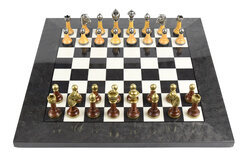The Rules of Modern European Chess
At Masters Traditional Games, we always aim for excellent quality but we also like to find games that are a bit special or unusual too. With Chess, it is particularly easy to go and buy any old Chess set from a mundane high-street shop. Why do that, when we can find you something a lot more interesting?
See also: Buy Chess Sets.
Equipment
The game of Chess is played on a square chequered board of 64 squares. The pieces for each player consist of 8 Pawns, 2 Rooks also known as castles, 2 Knights, 2 Bishops, a King and a Queen. The real colours of the pieces and the board do not necessarily need to be black and white but they are normally referred to as black and white, regardless. The board is placed between the two opponents so that the near right-hand corner square is white for both players.
In many top level games, a chess clock is used. This keeps track of the amount of the total amount of time for each player's moves so far. There is an upper limit on the total amount of time that a player can take and when the player exceeds this limit, that player loses.
Preparation and Objective
Each player's eight Pawns are placed on the second nearest row to the player. The remaining pieces are placed on the row nearest to the player in the following way: the Rooks in each corner, the Knights on the next square in from the corner, the Bishops next to the Knights. Of the two squares remaining, the Queen is placed on the square that is the same colour as the Queen. The King is placed on the remaining square.
The objective of the game is to capture the opposing player's King. The King is never actually taken; instead the aim is put the opponent's King into a position such that the opposing player can do nothing to avoid the King being taken next turn. As soon as this happens, the victorious player who has just moved says "checkmate" and the game is over.
Basic Play
Players take turns to move a piece of their own colour. White moves first. Each piece is moved according to different rules but no two pieces can occupy the same square. If a piece moves so that its final position is a square occupied by an opposing piece, the opposing piece is "captured" or "taken" and is removed from the board. It is not compulsory to capture. Any square that could be moved into by a piece is said to be "attacked" by that piece. When a piece is moved to a position that attacks the square occupied by the opponent's King, the King is in "check" and the player who moved the piece must clearly say "check".
- King - moves one space in any direction diagonally or orthogonally EXCEPT that the King cannot move onto a square that is attacked by an opposing piece.
- Queen - moves any number of spaces in any direction, diagonally or orthogonally but cannot jump over another piece.
- Rook - moves any number of spaces orthogonally but cannot jump over another piece.
- Bishop - moves any number of spaces diagonally but cannot jump over another piece.
- Knight - moves one square orthogonally and then one square diagonally. The Knight is the only piece that can jump over other pieces.
- Pawn - The first move of a Pawn can be either one square or two squares forward. Thereafter, the standard move of a pawn is to move one square forwards. However, the pawn is the only piece that moves differently when capturing:- a Pawn takes another piece by moving forward one square diagonally .
Special rules
En Passant
If a Pawn in the fifth row is in the situation where an opposing Pawn moves next to it by moving for the first time and opting to move two squares, the Pawn in the fifth row may take the opposing Pawn by moving forward one square diagonally behind the opposing pawn. i.e. the Pawn takes as though the opposing Pawn moved only one square instead of two. En Passant is French for "In passing" so, in English, the Pawn is "taken in passing".
Castling
Once per game, a player may choose to "castle" instead of a playing standard move. Castling is effected by moving both a Rook and the King in the same move so that they cross over each other but this special move can only be done if all the following criteria are met:
- Neither the King or the Rook have yet moved.
- There are no pieces between the King and the Rook.
- The King is not in check.
- The square that the King moves over is not being attacked by an opposing piece.
If the above are all true, a player can castle by moving the the King two places towards the Rook and, in the same move, repositioning the Rook next to the King on the square that the King moved over. Castling is usually done to protect the King behind a row of Pawns and/or to move a Rook into play alongside the other Rook since a pair of Rooks is a powerful combination.
Promotion of Pawns
If a Pawn reaches the eighth row, that Pawn is immediately promoted by replacing the Pawn with another piece - Queen, Rook, Bishop or Knight at the player's discretion. Normally, a player chooses to replace the Pawn with the most powerful piece, the Queen. There is no problem with having more than one Queen or more than two of the other pieces on the board at the same time. Although Pawns rarely do get promoted, the threat posed by a Pawn nearing the other side of the board can be a useful tactical weapon.
Finishing
Checkmate
When a piece is moved so it puts the opposing King in check, the King must get out of check in the next turn. There are only three ways to do this:
- The attacking piece may be taken by the King or another piece.
- Another piece may be moved between the attacking piece and the King (unless the attacking piece is a Knight, of course).
- The King may move to an adjacent square that is not under attack.
If the King cannot move out of check in one of these ways, the player who puts the King in check says "checkmate" instead of "check" and the game finishes.
Stalemate and other Draw situations
In chess, a draw can happen in one of the following ways:
- A player's King is not in check but that player cannot move without placing the King in check. This situation is known as Stalemate.
- It becomes impossible for either player to checkmate with the pieces remaining.
- The same position of pieces is repeated three times with the same player to move each time.
- One player proposes a stalemate and the other player agrees to the proposal.
Resignation
Once it is believed that the opposing player will inevitably win, a player will normally resign to save time. A player traditionally resigns by tipping over his or her King.
These rules are provided by Masters Traditional Games, an Internet shop selling quality traditional games, pub games and unusual games. For general information or for copying and copyright, see our Rules Information page.
Our rules are comprehensive instructions for friendly play. If in doubt, always abide by locally-played or house rules.
Copyright James Masters, 2025. All rights reserved.








































